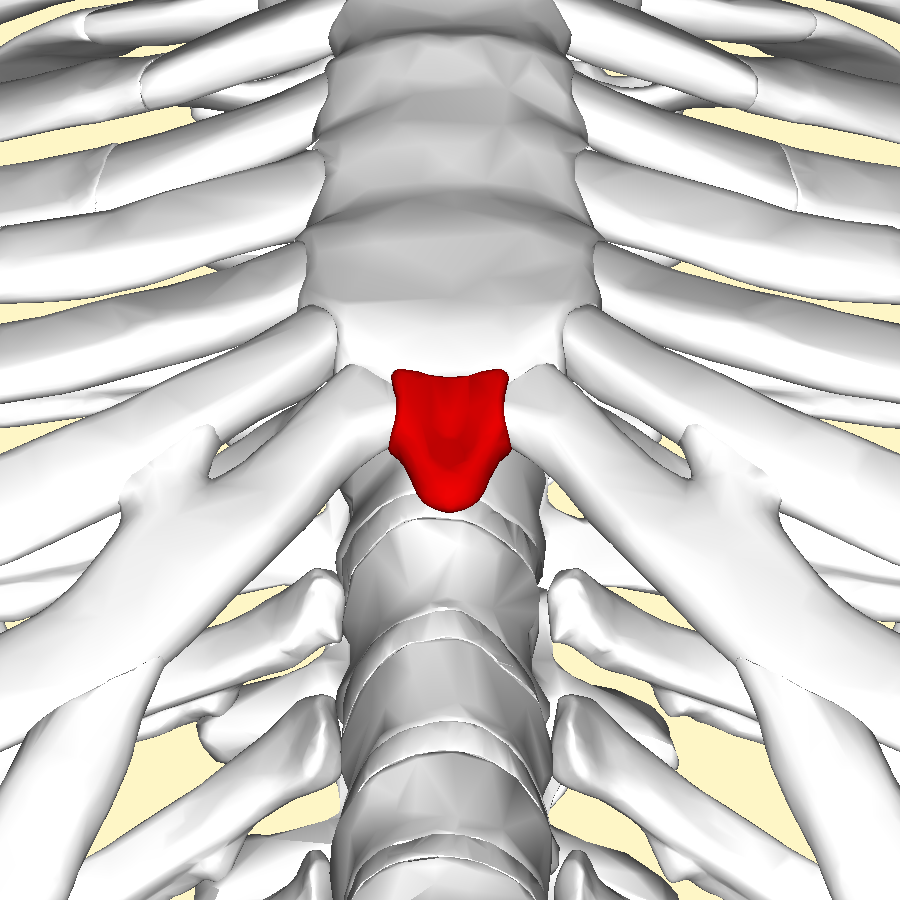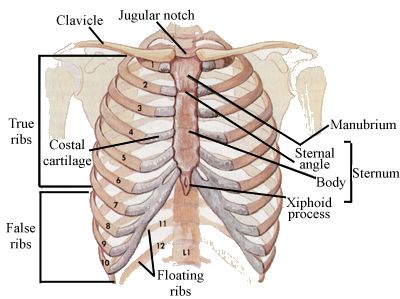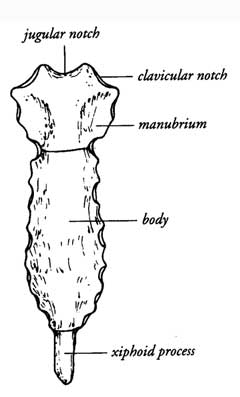Xiphoid Process Definition
The xiphoid process is the third and lowermost part of the sternum. It is a relatively small projection or outgrowth from the lowest end of the sternum. The xiphoid process is the smallest and most variable part of the sternum. Located at the lower end of the sternum, the xiphoid process may be triangular with a pointed caudal end, broad and flat, bifid, perforated, deflected to one side or curved anteriorly. The root of the word comes from the Greek word ‘xiphos’, which means ‘straight sword’. The tapered piece of bone is also known by the following names:
- Metasternum
- Xiphisternum
- Ensiform process
- Ensiform cartilage
- Xiphoid cartilage
Xiphoid process Location
The xiphoid process is considered to be located at the level of the 9th sternum or just below the nipple line at the center of the chest.
Xiphoid Process Structure
Upper end: At the xiphisternal joint, the upper part of the xiphoid process meets the middle part of the sternum- body. The upper part of the process has a demi-facet at its lateral angle which articulates with the seventh costal cartilage with a similar facet of the sternal body.
Lower end: The lower end or tip gives attachment to linea Alba, while the aponeuroses of internal obliques and transversus abdominis get attached to the lateral borders.
Anterior surface: The anterior surface affords attachment to a slip of rectus abdominis along with the aponeuroses of external and internal oblique muscles (anterior wall of rectus sheath).
Posterior surface: This surface of the xiphoid process gives attachment to the lower part of the sternocostalis and sternal origins of the diaphragm. The sub-diaphragmatic part of the posterior surface is related to the left lobe of the liver, slightly to the left of the falciform ligament. Sometimes foramen of Morgagni is present when diaphragm slips are absent.
Xiphoid process Function
The ensiform cartilage serves as an important site of attachment for the following muscles:
- Diaphragm: It is a thin dome-shaped skeletal muscle that separates the thoracic cavity from the abdomen to ensure normal respiration.
- Rectus abdominis muscle: This is a long flat muscle of the anterior abdominal wall that supports the spinal muscles during strenuous activities as well as facilitates regular breathing movements. Most importantly, it keeps the intestines and other organs in the abdomen intact.
- Transversus thoracis muscle: It is a flat muscle composed of transverse fibers that line the anterior and lateral walls of the abdominal cavity.
The protruding structure also helps in locating the pericardium for drawing out fluid as a part of pericardiocentesis. The cartilage of the solar plexus also joins to the xiphoid process. It also indirectly administers the attachment of costal cartilages to the sternum.
Xiphoid Process Conditions
Broken Xiphoid process
As the metasternum is a single bone and not guarded by the rib bones, it gets damaged or breaks very easily.
Causes
A broken xiphoid process can be the result of a sudden and heavy blow to the chest. It may also break during a CPR leading to diaphragm puncture.
Symptoms
Following are the symptoms of a broken xiphoid process.
- Unbearable pain the chest
- Difficulty in breathing as the diaphragm gets punctures.
- Abdominal cramps as the abdominal muscles like linea alba, rectus abdominis etc., are attached to this protruding structure.
- Upper abdominal bloating.
Diagnosis
A broken xiphoid process can easily be determined by a sternal X-Ray since it is a bony structure.
Treatment
Treatment generally is natural healing process with complete immobilization of the sternum. It takes about 6 weeks for complete healing. Physiotherapy and light diets may increase the rate of healing. If affordable the individual may undergo a surgery for faster recovery. The surgery includes rigid fixation by an instrument called Talon. It is a difficult surgery and if not in expert hands livers may get punctured causing internal bleeding and further complication of the process.
Xiphodynia
Xiphodynia is also known as Xiphoid Syndrome or Xiphoidalgia. It is the condition in which the xiphoid process gets protruded or swollen.
Causes
This small fragmentary single bone may protrude outwardly owing to loss or gain of too much of weight as the imbalance pressure bends the xiphoid process. Lifting heavy weight also creates enough pressure by which the process can protrude outward.
Symptoms
Following symptoms can be seen in case of a Xiphoidalgia-
- Tender chest
- A feeling of discomfort in chest
- Tenderness in shoulder
- Weakness of back muscles and severe back pain
- Epigastric discomfort supplemented by tenderness
- Unbearable chest and shoulder pain
- Nausea, vomiting, and diarrhea in extreme conditions
Diagnosis
Generally, a Xiphodynia will give rise to a radiating pain to the back and the shoulder. It is called referral pain as the pain occurs at a place far away from the origin of pain stimuli. The diagnosis can be confirmed by radiological or imaging techniques of which X-ray and ultrasound are the most common. Although easy to diagnose is one of the most uncommon disorders, this disease is usually looked upon in its early stages or misdiagnosed leading to wrong treatment which gives birth to more complicated situations.
Treatment
The Xiphoid Syndrome causes pain which may be mild or severe. The treatment depends on the severity of pain.
At a mild stage, the pain is controlled by painkillers (like analgesics) and NSAIDs (non-steroidal anti-inflammatory drug). Both the drugs must be used together as the first one will give relief to the individual while the NSAIDs will decrease the rate of inflammation. If the analgesic fails to kill the pain then the medicines should immediately be replaced by opioid drugs (opioid painkillers are illegal if not being prescribed by a professional). The pain may decrease either by application of heat or by application of cold; it varies in individuals. The rate of warmth or coldness can only be controlled by an expert. If the pain disagrees to depress even after undertaking all the above-mentioned measurements, the doctor may go for injecting lidocaine (a local anesthetic) or corticosteroids directly into the xiphoid process.
But these chemical have several side-effects like an infection which turns to be a fatal, pneumothorax and peritoneal perforation. Since xiphodynia is a musculoskeletal disorder physical therapy will suddenly soothe the pain. Pressure rib belts may be used as they provide support to the sternum which in turn will comfort the affected individual. Sometimes this disease is associated with Gastroesophageal Reflux Disease (GERD). In that situation, heavy diets must be avoided. If all the treatments mentioned fails to decrease pain then the individual may go for xiphoidictomy (removal of the xiphoid process).
Retrosternal diaphragmatic hernia
It is a congenital disorder also known as Morgagni hernia as the herniation takes place through the foramen of Morgagni.
Cause
It is associated with the absence of sternal slips of the diaphragm which leads to the formation of the foramen between the xiphoid process and the rest of the diaphragm.
Diagnosis
The disease can be diagnosed easily by an ultrasound or X-ray.
Treatment
Today this disease can easily be cured through the laparoscopic operation.




My xiphoid process was removed do to a bone infection. What should my expectations be?